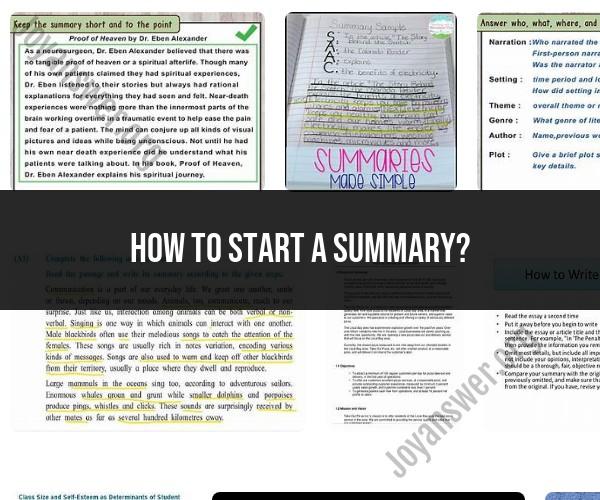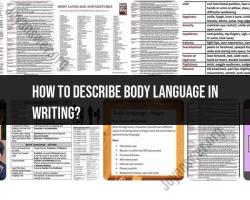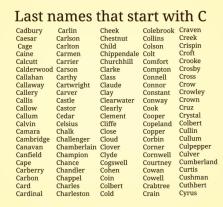How to start a summary?
Starting a summary effectively is essential to grab the reader's attention and provide a clear overview of the main points of the text you are summarizing. Here are some effective introduction techniques to begin a summary:
Start with a Concise Statement:
- Begin your summary with a clear and concise statement of the main idea or central theme of the original text. This immediately sets the tone for the rest of your summary.
- Example: "In this article, the author explores the impact of climate change on global food security."
Use a Hook:
- Start with a compelling hook or attention-grabbing statement related to the text's topic. This can pique the reader's interest and encourage them to continue reading.
- Example: "Imagine a world where clean, renewable energy sources power our cities and reduce our carbon footprint."
Provide Context:
- Offer a brief context or background information about the text, its author, and its significance. This helps the reader understand the context in which the original work was created.
- Example: "Written by renowned scientist Dr. Jane Smith, this research paper delves into the mysteries of quantum physics."
State the Author's Purpose:
- Clearly state the author's purpose or the reason behind writing the text. This helps the reader understand the author's intentions and objectives.
- Example: "In this essay, the author aims to persuade readers to take action against deforestation."
Highlight the Main Points:
- Provide a brief overview of the key points or arguments that the author makes in the text. This gives the reader an idea of what to expect in the summary.
- Example: "The article discusses three main factors contributing to the rise in childhood obesity: unhealthy diets, sedentary lifestyles, and lack of education."
Pose a Question:
- Start with a thought-provoking question related to the text's topic. This encourages the reader to think critically about the subject matter.
- Example: "What are the long-term consequences of our dependence on fossil fuels for energy?"
Use a Quotation:
- Incorporate a relevant and impactful quotation from the original text. This can provide insight into the author's style and perspective.
- Example: "'The only way to do great work is to love what you do,' wrote Steve Jobs in his inspirational speech."
Employ a Contrast or Comparison:
- Highlight a striking contrast or comparison found in the text. This can be an effective way to draw attention to key elements of the content.
- Example: "While some argue that technology isolates us, the author contends that it can also connect us in unprecedented ways."
Set the Tone:
- Establish the tone of your summary in the introduction. Whether it's formal, informal, academic, or persuasive, the tone should align with the content and purpose of your summary.
- Example: "In this lighthearted and humorous essay, the author explores the quirks of modern life."
State Your Thesis:
- If you are writing a formal summary, consider starting with a clear thesis statement that summarizes the main argument or message of the text.
- Example: "The thesis of this research paper is that technological advancements have revolutionized the way we communicate and interact."
Choose an introduction technique that best suits the nature of the text you are summarizing and your intended audience. The goal is to engage the reader and provide a concise preview of the content that follows in your summary.
Here are some tips on how to begin a summary:
- Start with a strong hook. The first sentence of your summary should grab the reader's attention and make them want to read more. You can do this by asking a question, stating an interesting fact, or using a strong quote.
- Identify the main idea. What is the main point of the text that you are summarizing? Once you know the main idea, you can start to write a sentence that states it clearly and concisely.
- Use your own words. It is important to summarize the text in your own words, rather than simply copying it. This will help you to understand the text better and to write a more concise summary.
- Be selective. Don't try to include every detail from the text in your summary. Focus on the most important information and the main points.
- Keep it short. A summary should be a concise overview of the text. Aim for a summary that is no more than a few paragraphs long.
Here are some examples of effective summary openings:
- Question: Have you ever wondered what it would be like to live on Mars? In his article, "The Future of Mars Exploration," Elon Musk outlines his plans for colonizing the Red Planet.
- Fact: Did you know that the human brain can generate enough electricity to power a small light bulb? In her book, "Spark: The Revolutionary New Science of Exercise and the Brain," Dr. John J. Ratey discusses the many benefits of exercise for the brain.
- Quote: "The only way to do great work is to love what you do." - Steve Jobs. In his book, "Creativity, Inc.," Pixar co-founder Ed Catmull shares the secrets of building a creative culture.
By following these tips, you can write a strong and effective summary opening that will grab the reader's attention and make them want to read more.













